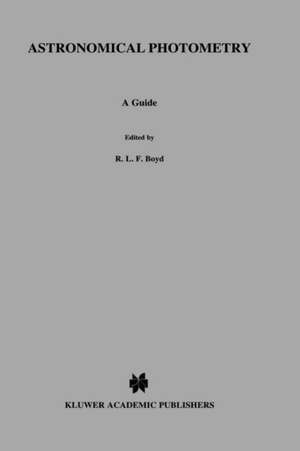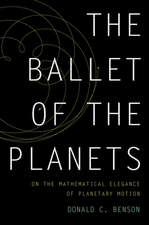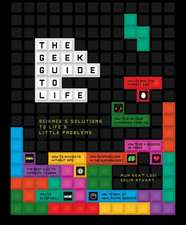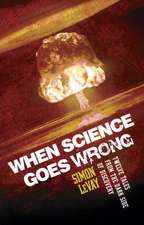Astronomical Photometry: A Guide: Astrophysics and Space Science Library, cartea 175
Autor C. Sterken, J. Manfroiden Limba Engleză Hardback – 30 apr 1992
The book is based on the authors' observing experience, spending numerious nights behind various instruments at many different observatories.
| Toate formatele și edițiile | Preț | Express |
|---|---|---|
| Paperback (1) | 640.06 lei 6-8 săpt. | |
| SPRINGER NETHERLANDS – 30 apr 1992 | 640.06 lei 6-8 săpt. | |
| Hardback (1) | 647.40 lei 6-8 săpt. | |
| SPRINGER NETHERLANDS – 30 apr 1992 | 647.40 lei 6-8 săpt. |
Din seria Astrophysics and Space Science Library
- 24%
 Preț: 799.10 lei
Preț: 799.10 lei - 15%
 Preț: 647.92 lei
Preț: 647.92 lei - 18%
 Preț: 983.81 lei
Preț: 983.81 lei - 18%
 Preț: 790.28 lei
Preț: 790.28 lei -
 Preț: 359.86 lei
Preț: 359.86 lei -
 Preț: 389.71 lei
Preț: 389.71 lei - 20%
 Preț: 691.14 lei
Preț: 691.14 lei - 20%
 Preț: 816.18 lei
Preț: 816.18 lei - 18%
 Preț: 1011.27 lei
Preț: 1011.27 lei -
 Preț: 402.56 lei
Preț: 402.56 lei - 15%
 Preț: 664.93 lei
Preț: 664.93 lei -
 Preț: 398.15 lei
Preț: 398.15 lei - 18%
 Preț: 954.77 lei
Preț: 954.77 lei -
 Preț: 411.04 lei
Preț: 411.04 lei - 18%
 Preț: 1225.31 lei
Preț: 1225.31 lei - 18%
 Preț: 1843.29 lei
Preț: 1843.29 lei -
 Preț: 393.13 lei
Preț: 393.13 lei -
 Preț: 400.26 lei
Preț: 400.26 lei - 18%
 Preț: 953.82 lei
Preț: 953.82 lei - 18%
 Preț: 960.61 lei
Preț: 960.61 lei -
 Preț: 398.35 lei
Preț: 398.35 lei -
 Preț: 390.84 lei
Preț: 390.84 lei -
 Preț: 413.76 lei
Preț: 413.76 lei -
 Preț: 416.64 lei
Preț: 416.64 lei - 18%
 Preț: 947.67 lei
Preț: 947.67 lei -
 Preț: 404.51 lei
Preț: 404.51 lei - 18%
 Preț: 956.50 lei
Preț: 956.50 lei -
 Preț: 403.75 lei
Preț: 403.75 lei - 18%
 Preț: 1229.40 lei
Preț: 1229.40 lei - 18%
 Preț: 1224.99 lei
Preț: 1224.99 lei -
 Preț: 404.29 lei
Preț: 404.29 lei - 15%
 Preț: 654.77 lei
Preț: 654.77 lei - 18%
 Preț: 1248.20 lei
Preț: 1248.20 lei - 18%
 Preț: 955.25 lei
Preț: 955.25 lei - 18%
 Preț: 1846.28 lei
Preț: 1846.28 lei - 18%
 Preț: 1233.06 lei
Preț: 1233.06 lei - 18%
 Preț: 1234.77 lei
Preț: 1234.77 lei
Preț: 647.40 lei
Preț vechi: 761.65 lei
-15% Nou
Puncte Express: 971
Preț estimativ în valută:
123.88€ • 132.47$ • 103.29£
123.88€ • 132.47$ • 103.29£
Carte tipărită la comandă
Livrare economică 18 aprilie-02 mai
Preluare comenzi: 021 569.72.76
Specificații
ISBN-13: 9780792316534
ISBN-10: 0792316533
Pagini: 272
Ilustrații: XII, 272 p.
Dimensiuni: 155 x 235 x 22 mm
Greutate: 0.61 kg
Ediția:1992
Editura: SPRINGER NETHERLANDS
Colecția Springer
Seria Astrophysics and Space Science Library
Locul publicării:Dordrecht, Netherlands
ISBN-10: 0792316533
Pagini: 272
Ilustrații: XII, 272 p.
Dimensiuni: 155 x 235 x 22 mm
Greutate: 0.61 kg
Ediția:1992
Editura: SPRINGER NETHERLANDS
Colecția Springer
Seria Astrophysics and Space Science Library
Locul publicării:Dordrecht, Netherlands
Public țintă
ResearchCuprins
1 Introduction.- 1.1 The quantum nature of light.- 1.2 Photometric concepts and radiometric quantities.- 1.3 Natural sources of diffuse illumination.- 1.4 Detectors.- 1.5 The most versatile detector of light images.- 1.6 Ancient catalogues.- 1.7 Definition of the magnitude scale.- 1.8 The perception of colors.- 1.9 Colors and visual observations.- 1.10 Major sources of errors in ancient visual observations.- 1.11 Magnitude.- 1.12 Magnitude systems.- 1.13 Bolometric magnitude.- 1.14 Apparent and absolute magnitudes.- 1.15 Color index.- 1.16 Characteristics of the photometric response curve.- 2 The telescope.- 2.1 Types.- 2.2 Requirements and specifications.- 3 Photoelectric photometers.- 3.1 Types of photoelectric photometers.- 3.2 The sequential photometer.- 3.3 The simultaneous photometer.- 3.4 The multi-star photometer.- 4 The photomultiplier.- 4.1 The photoelectric effect.- 4.2 Types of photomultipliers.- 4.3 The essential parts of a photomultiplier tube.- 4.4 Anode current and its measurement.- 4.5 Characteristics of photomultipliers.- 5 Photometric filters.- 5.1 Fundamental characteristics.- 5.2 Gelatin filters.- 5.3 Glass filters.- 5.4 Interference filters.- 5.5 Custom-design filters.- 5.6 Image-quality filters.- 5.7 Neutral-density filters.- 5.8 Circular variable filters.- 6 Atmospheric extinction.- 6.1 Absorption, scattering and dispersion of light.- 6.2 Monochromatic extinction.- 6.3 Definition of the air mass.- 6.4 Calculation of the air mass.- 6.5 Heterochromatic extinction.- 6.6 Conclusions.- 7 Atmospheric turbulence: scintillation and seeing.- 7.1 Scintillation.- 7.2 Seeing.- 8 Color transformation.- 8.1 Introduction.- 8.2 Narrow-band photometry.- 8.3 The general color-transformation problem.- 9 Interstellar extinction.- 9.1 Monochromatic extinction.- 9.2 Wide-band extinction.- 10 Principles of data analysis.- 10.1 Introduction.- 10.2 Monochromatic photometry.- 10.3 Multifilter photometry.- 10.4 General remarks.- 10.5 Examples of reduction algorithms.- 11 Homogenization.- 11.1 Introduction.- 11.2 Conformity.- 11.3 Homogenization.- 11.4 Merging data from a single system.- 11.5 Conclusions.- 12 Infrared photometry.- 12.1 Introduction.- 12.2 Chopping and nodding.- 12.3 The detector.- 12.4 The photometer.- 12.5 Observation and reduction of infrared data.- 12.6 Day-time observing.- 13 Charge-coupled devices.- 13.1 Introduction.- 13.2 The detector.- 13.3 The camera.- 13.4 Characteristics of CCDs.- 13.5 Extraction of data from a frame.- 13.6 Aperture photometry.- 13.7 Profile fitting.- 13.8 Extinction.- 13.9 Color transformation.- 14 Photographic photometry.- 14.1 Introduction.- 14.2 The photographic emulsion as a storage medium.- 14.3 The characteristic curve.- 14.4 Post-observational processing of plates and films.- 14.5 Calibration of digitally recorded photographic densities.- 14.6 Photometric analysis of photographic intensities.- 15 The observations.- 15.1 Introduction.- 15.2 Preparing the observing run.- 15.3 Programme scheduling.- 15.4 Evaluation of the quality of the signal for non-imaging detectors.- 15.5 Noise and error on sky background.- 15.6 Some practical hints.- 16 Photometric systems.- 16.1 Introduction.- 16.2 The visual system.- 16.3 Photographic systems.- 16.4 Photoelectric systems.- 16.5 Absolute calibration.- Appendix A. References.- Appendix B. Glossary.- Appendix C. Symbols and notations.- Appendix D. Index.

















